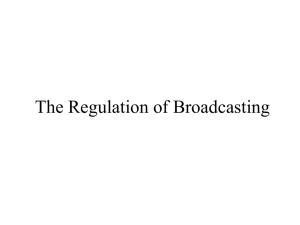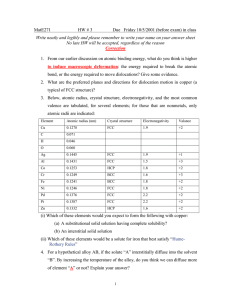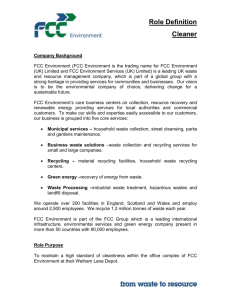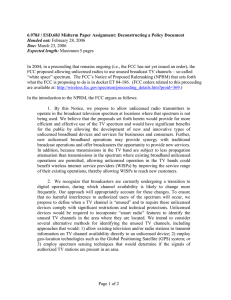ITU-R SG 1/WP 1B WORKSHOP: SPECTRUM MANAGEMENT ISSUES ON COGNITIVE RADIO SYSTEMS
advertisement
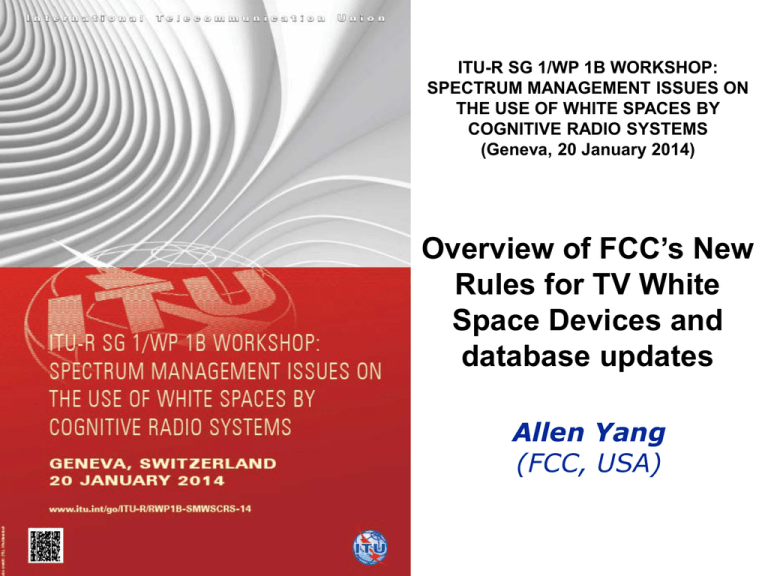
ITU-R SG 1/WP 1B WORKSHOP: SPECTRUM MANAGEMENT ISSUES ON THE USE OF WHITE SPACES BY COGNITIVE RADIO SYSTEMS (Geneva, 20 January 2014) Overview of FCC’s New Rules for TV White Space Devices and database updates Allen Yang (FCC, USA) International Telecommunication Union TV Bands Devices Background • 2002 – Notice of Inquiry in ET Docket 02-380 initiated in 2002 to consider operation of devices in TV White Spaces • 2004 – Notice of Proposed Rule Making (NPRM) in ET Docket 04-186 issued in 2004 • 2006 - First Report and Order and Further Notice of Proposed Rule Making • 2007-8 – Prototype Sensing Capability Testing and Reports • 2008 – Second Report and Order • 2010 – Second Memorandum Opinion and Order • 2011 – FCC approves first TVWS database administrator and devices Background • 2012 – Third Memorandum Opinion and Order : http://hraunfoss.fcc.gov/edocs_public/attachmatch/FCC-1236A1.pdf - This action addressed the following issues raised in petitions for reconsideration: (1) the height above average terrain (HAAT) limit for TV bands devices; (2) out-of-band emission limits; (3) protection of wireless services on TV channel 52; (4) establishment of a new category of fixed indoor TV bands devices; and (5) the confidentiality of certain information in the TV bands database. TV White Spaces • In any given TV market area, a number of channels are unassigned to avoid interference • Channels may also be assigned for low power TV & TV translators & 14 – 20 for land mobile service in 13 major cities • Also can be used for wireless microphones, broadcast auxiliary and offshore telephone service (Gulf of Mexico region only) • “White Spaces” are the channels that are “unused” at any given location 2 4 Low Power TV New York City Full Power TV Stations 5 White Space 7 9 Wireless Microphones Etc. Only for illustrative purposes White Space Philadelphia Full Power TV Stations NonBroadcast spectrum 3 Low Power TV NonBroadcast spectrum White Space 6 White Space 8 10 Wireless Microphones Etc. Overview of Rules • Provide for both fixed and personal/portable devices to operate in the TV white spaces on an unlicensed basis • Devices must include a geolocation capability and capability to access to a database of protected radio services • Devices provide their location to their database, which returns a list of channels on which they may operate (channel lists are specific to the location of the device) • Devices must complete the database access process before operating • Databases are established and administered by third parties; were selected through a public notice process that solicited interested parties Additional Provisions to Mitigate Interference Risk • Fixed devices must register their locations in the database • Fixed and personal/portable devices must provide identifying info to the database • Devices cannot transmit without checking database and must recheck periodically • All devices must include adaptable power control to use the minimum necessary power Certification Required • White space devices must be certificated • FCC Lab requests samples for testing • FCC will remove from the market any equipment causing harmful interference • FCC will require users to remedy any interference that may occur; responsible parties to correct compliance issues with devices Fixed Devices • May operate on channels 2 - 51, except 3, 4 and 37 • May not operate adjacent to an occupied TV channel • Location set by geolocation capability or professional installation • Device checks database for available channels Personal/Portable Devices • May operate on channels 21 - 51, except channel 37 • Location: See Modes 1 & 2 • Device must check database for permissible channels Mode 1: Portable device obtains location/channels from fixed device Mode 2: Portable device has its own geolocation/database access capability FCC Authorizes Nationwide use of TVWS • • This action follows the launch of the Commission’s on-line registration system for large entertainment, sports, and similar venues where a significant number of unlicensed wireless microphones are used (unlicensed wireless microphone registration system). The Commission’s rules permit unlicensed radio devices to transmit on white space in the spectrum bands used by the broadcast television service, i.e., 54-72 MHz, 76-88 MHz, 174-216 MHz, 470-608 MHz and 614-698 MHz. The FCC rules require that TV white space database systems protect the following radio services and receive-only operations (authorized services): – 1) broadcast television stations (including full power, TV translator, low power TV, and Class A stations); – 2) fixed broadcast auxiliary service (BAS) links (regular licensed and temporary); – 3) receive sites (and received channels) of TV translator, low power and Class A TV stations, and multichannel video programming distributors (MVPDs – cable and satellite TV systems); – 4) public safety and private land mobile operations; – 5) offshore radio telephone service operations; – 6) radio astronomy service operations at specific sites; and – 7) low power auxiliary service operations (licensed and certain approved unlicensed wireless microphone venue sites). FCC Authorizes Nationwide use of TVWS • This nationwide operating authority applies to those database systems that were already approved by the FCC, i.e., the systems of Spectrum Bridge, Inc. and iconectiv (formerly Telcordia Technologies, Inc.), as well as those subsequently approved by OET, which thus far include Google, Inc. and Key Bridge Global, LLC. • There are currently 10 authorized TV bands white space database administrators, four of which (as indicated above) are currently approved by OET to provide service to TV white space devices. More Information • http://www.fcc.gov/encyclopedia/white-space-databaseadministration


